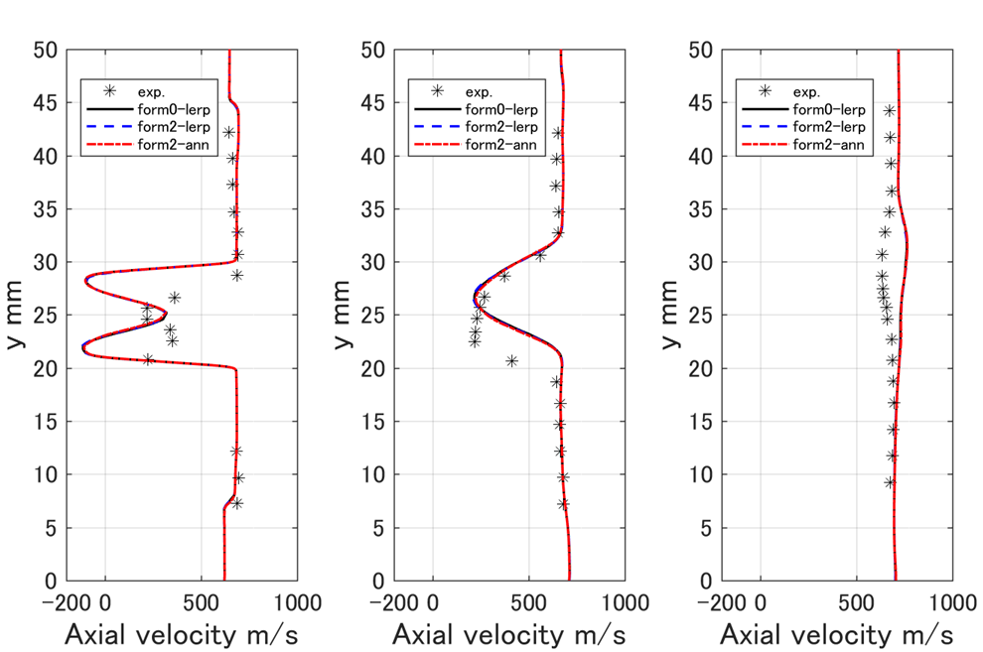Research on combustor simulation
JAXA Supercomputer System Annual Report April 2019-March 2020
Report Number: R19ETET05
Subject Category: Skills Acquisition System
- Responsible Representative: AOYAMA Takashi, Director, Aeronautical Technology Directorate, Numerical Simulation Research Unit
- Contact Information: Himeko Yamamoto(himeko@toki.waseda.jp)
- Members: Himeko Yamamoto
Abstract
For the development of a aircraft engine combustor with high environmental compatibility, we develop the combustion calculation methods that can reproduce the pressure propagation and chemical reaction with practical calculation cost. In addition, numerical simulations of the DLR scramjet test-engine combustor are conducted to evaluate these proposed methods.
Reference URL
N/A
Reasons and benefits of using JAXA Supercomputer System
It is necessary to use supercomputer to conduct development and verification of the combustion calculation methods.
Achievements of the Year
The laminar flamelet model, which is a tabulated chemistry method, is effective for reducing the inflexibility of numerical simulation of combustion. However, the recently proposed compressible flamelet model, which is applicable to compressible flow, has some problems of computational performance related to increased complication of the flamelet table and the pressure-calculation process. To address these problems of the conventional method (form0-lerp) of the compressible flamelet model which uses conventional formulation (form0) and flamelet table with linear interpolation (Lerp), we propose two formulations, namely form1 and form2. Form1 has the advantage of making the spatial gradient calculation of each chemical species mass fraction more efficient. Form2 has the advantage of eliminating the calculation procedure that depends on the number of chemical species. We also propose methods of utilizing artificial neural network (ANN) that produce synergistic effects with these formulations. In addition, to evaluate two particularly effective methods, form2-lerp and form2-ann, numerical simulations (Fig.2, Fig.3) based on the DLR scramjet test-engine combustor (Fig.1) are conducted.
Publications
– Peer-reviewed papers
Himeko Yamamoto, Rui Toyonaga, Yusuke Komatsu, Koki Kabayama, Yasuhiro Mizobuchi, Tetsuya Sato, “Improved Methods of Laminar Flamelet Model for Compressible Flow”, AIAA Journal, American Institute of Aeronautics and Astronautics (2020.3, accepted)
Usage of JSS2
Computational Information
- Process Parallelization Methods: MPI
- Thread Parallelization Methods: N/A
- Number of Processes: 2 – 1024
- Elapsed Time per Case: 120 Hour(s)
Resources Used
Fraction of Usage in Total Resources*1(%): 0.11
Details
Please refer to System Configuration of JSS2 for the system configuration and major specifications of JSS2.
| System Name | Amount of Core Time(core x hours) | Fraction of Usage*2(%) |
|---|---|---|
| SORA-MA | 877,071.08 | 0.11 |
| SORA-PP | 7,887.09 | 0.05 |
| SORA-LM | 0.00 | 0.00 |
| SORA-TPP | 0.00 | 0.00 |
| File System Name | Storage Assigned(GiB) | Fraction of Usage*2(%) |
|---|---|---|
| /home | 476.84 | 0.40 |
| /data | 39,062.52 | 0.67 |
| /ltmp | 1,953.13 | 0.17 |
| Archiver Name | Storage Used(TiB) | Fraction of Usage*2(%) |
|---|---|---|
| J-SPACE | 0.48 | 0.01 |
*1: Fraction of Usage in Total Resources: Weighted average of three resource types (Computing, File System, and Archiver).
*2: Fraction of Usage:Percentage of usage relative to each resource used in one year.
JAXA Supercomputer System Annual Report April 2019-March 2020





